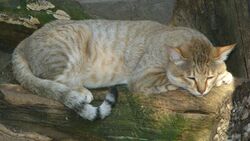Biology:Arabian wildcat
| Arabian wildcat | |
|---|---|

| |
| Arabian wildcat at Olomouc Zoo | |
| Scientific classification | |
| Domain: | Eukaryota |
| Kingdom: | Animalia |
| Phylum: | Chordata |
| Class: | Mammalia |
| Order: | Carnivora |
| Suborder: | Feliformia |
| Family: | Felidae |
| Subfamily: | Felinae |
| Genus: | Felis |
| Species: | |
| Subspecies: | F. l. lybica
|
| Trinomial name | |
| Felis lybica lybica Forster, 1780
| |
The Arabian wildcat (Felis lybica lybica), also called Gordon's wildcat is a wildcat subspecies that inhabits the Arabian Peninsula. It was first described in 1968 by British zoologist David Harrison who named it Felis silvestris gordoni in honour of Major A.C. Gordon who collected the type specimen in Oman.[1]
Taxonomy
The Arabian wildcat's taxonomic status has been debated since the 1990s:
- In the 2005 edition of Mammal Species of the World, it was recognised as a Felis silvestris subspecies with the name Felis silvestris gordoni.[2]
- In 2007, following phylogenetic research, it was subsumed to F. s. lybica, the Near Eastern wildcat.[3]
- Since 2017, Felis lybica is recognised as a wildcat species distinct from Felis silvestris, and the Arabian wildcat is now recognised as the nominate lybica subspecies F. l. lybica.[4]
Characteristics
The Arabian wildcat is quite similar to a domestic cat in size and appearance. Its fur is short and dense, greyish-brown, ash grey or buff, with dark markings on the head and dark banding on the body, limbs and near the tip of the tail. The underparts are whitish, and there are black hairs between the black pads on the soles of the feet.[5]
Distribution and habitat
This cat is endemic to northern Oman and parts of the United Arab Emirates. Its typical habitat is semidesert areas with rock and scrub where males maintain a territory which may measure several square km, and females a rather smaller territory.[5]
Ecology
The Arabian wildcat is nocturnal; it is a solitary animal and has several dens, rock crevices, hollow trees or empty fox burrows, into which it can retreat in different parts of its territory. It feeds on jerboas, jirds and other small rodents, small birds, reptiles and large insects, obtaining most of its fluid needs from its food. It is fierce and agile. Breeding takes place at most times of year.[6] The male is drawn to the female by the pheromones she produces when she is sexually receptive. The gestation period is about sixty-five days and the litter size is usually three or four kittens. The young have spotted coats at first and are weaned after two or three months, but stay with their mother for several months more to learn hunting and survival skills.[5]
Status
The range of the Arabian wildcat is small and it is one of the most threatened subspecies of wildcat. Historically persecuted by the Bedouin,[7] its habitat is now increasingly being degraded for agricultural purposes. The most serious threat it faces may be that it hybridises with feral domestic cats, and there may be few pure-bred Arabian wildcats remaining in the wild. With this in mind, a captive breeding program was started in 1986 in Abu Dhabi, and other cats have been relocated to California and Germany, with an international studbook being kept at Cologne Zoological Garden.[8]
References
- ↑ Harrison, D. (1968). The Mammals of Arabia. Volume II: Carnivora, Artiodactyla, Hyracoidea. London: Ernest Benn. p. 283. ISBN 978-0-8018-9533-3.
- ↑ Wozencraft, W.C. (2005). "Order Carnivora". in Wilson, D.E.; Reeder, D.M. Mammal Species of the World: A Taxonomic and Geographic Reference (3rd ed.). Johns Hopkins University Press. pp. 536–537. ISBN 978-0-8018-8221-0. OCLC 62265494. http://www.departments.bucknell.edu/biology/resources/msw3/browse.asp?id=14000065.
- ↑ Driscoll, C. A., Menotti-Raymond, M., Roca, A. L., Hupe K., Johnson, W. E., Geffen, E., Harley, E. H., Delibes, M., Pontier, D., Kitchener, A. C., Yamaguchi, N., O’Brien, S. J., Macdonald, D. W. (2007). "The Near Eastern origin of cat domestication". Science (317): 519−523.
- ↑ Kitchener, A. C.; Breitenmoser-Würsten, C.; Eizirik, E.; Gentry, A.; Werdelin, L.; Wilting, A.; Yamaguchi, N.; Abramov, A. V. et al. (2017). "A revised taxonomy of the Felidae: The final report of the Cat Classification Task Force of the IUCN Cat Specialist Group". Cat News (Special Issue 11). https://repository.si.edu/bitstream/handle/10088/32616/A_revised_Felidae_Taxonomy_CatNews.pdf?sequence=1&isAllowed=y.
- ↑ 5.0 5.1 5.2 Sharp, J.W.. "Arabian wildcat". DesertUSA. http://www.desertusa.com/animals/arabian-wildcat.html. Retrieved 4 December 2015.
- ↑ "Arabian wildcat". Natural UAE. UAEInteract. http://www.uaeinteract.com/nature/mammal/mam13.asp. Retrieved 4 December 2015.
- ↑ Hobbs, Joseph J. (January 1, 1995). Mount Sinai. University of Texas Press. p. 26. ISBN 978-0292730946. https://books.google.com/books?id=nRQQDQAAQBAJ&pg=PA26&lpg=PA26. "Sinai Bedouins apparently used burrow traps as late as the 1950s to kill the animal they perceived as a constant threat to livestock."
- ↑ "Gordon’s Wildcat F.s.gordoni". International Society for Endangered Cats. http://www.wildcatconservation.org/wild-cats/eurasia/wildcat-felis-silvestris/gordons-wildcat/. Retrieved 4 December 2015.
Wikidata ☰ Q521594 entry

